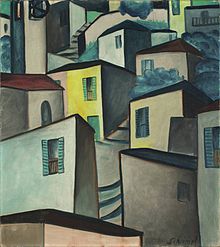Georg Schrimpf



Georg Schrimpf (13 February 1889 – 19 April 1938) was a German painter and graphic artist. Along with
Biographical details
Schrimpf was born in
With the outbreak of the
In 1916 the famous publicist and art expert
As early as the 1920s, Schrimpf was regarded as being a representative of the "right wing" of the
In 1925 Schrimpf participated in the Neue Sachlichkeit exhibition at the Mannheim Kunsthalle.[3] Two years later, he began teaching at the Meisterschule für Dekorationskunst in Munich. The "right-wing" of the movement were not immediately condemned by the Nazi regime at an early stage and were able to take on professorships in painting after the regime seized power in 1933.[4] Schrimpf's work was seen as an acceptable form of German Romanticism by the authorities.[6]
1932 saw the foundation of the Group Seven and the start of a touring exhibition by the group; the other members were Theo Champion, Adolf Dietrich, Hasso von Hugo, Franz Radziwill, as well as Kanoldt and Lenk.
Schrimpf became professor at the Royal School of Art in Berlin in 1933, but was fired in 1937 because of his “red past”.[6] He had been a short-time member of Rote Hilfe, a socialist organization. For the same reason the Nazi regime banned his works from public exhibitions. Schrimpf died in Berlin on 19 April 1938.[5]
Development and style
Schrimpf was self-taught. He drew compulsively as a child, drawing on his imagination and copying the works of others. In 1913, after his return from Ascona, he attended painting school in Munich but lasted only 8 days. His lack of confidence in his work meant he refused to show it to any but his friend Oskar Maria Graf. Persuaded to submit some examples to the Berlin publication "Aktion", Schrimpf was astonished when they were immediately accepted. His early supporters included the publicist and art patron Herwarth Walden, Herwarth of Der Sturm and Aktion, and the art historians Franz Roh and Werner Haftman.
Writing in 2012, for the catalogue of the exhibition "Modernist Masterpieces: the Haubrich Collection at Museum Ludwig" at the Museum Ludwig in Cologne, Olaf Peters says:
Schrimpf's artistic development emerged out of early Cubism. His paintings are characterised by a fixed composition, reduced and clear volumes, and Cubist simplification. His use of colour, however, has more in common with the Blauer Reiter group, setting clear highlights and making use of primary colours such as yellow and blue whose intensity disrupts the colour scheme. Schrimpf's figurative process, which he began to develop during the First World War, represents a synthesis of Jugendstil, Expressionism and Henri Rousseau's naive monumentality. The individual, harmoniously embedded in nature while simultaneously neutralised by it, appears as the main focus of the image. Moreover, religious allusions are not entirely absent in his works.[7]
Legacy

In 1995 Deutsche Bundespost honored Schrimpf with the issue of special stamp featuring his 1923 painting Still Life With Cat. The original painting is held by the Bayerische Staatsgemäldesammlungen, at the Staatsgalerie Moderne Kunst.[8][9]
Notes
References
- Crockett, Dennis (1999). German Post-Expressionism: The Art of the Great Disorder, 1918-1924. Cologne: ISBN 978-02710-179-69.
- Michalski, Sergiusz (2003). New Objectivity ("Neue Sachlichkeit: Malerei, Graphik und Photographie in Deutschland 1919-1933"). Cologne: ISBN 3-8228-9650-0.
- Olaf Peters (2012). Friedrich, Julia (ed.). Modernist Masterpieces: the Haubrich Collection at Museum Ludwig. ISBN 978-3-86335-174-8.
- Schmied, Wieland (1978). Neue Sachlichkeit and German Realism of the Twenties. London: ISBN 0-7287-0184-7.
External links
- "Georg Schrimpf". Ten Dreams. Retrieved 20 January 2013. Six of Shrimpf's paintings (by a non-profit organization)
- Georg Schrimpf at thegreatcat.org
